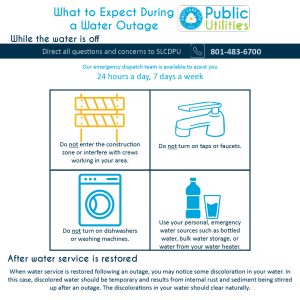What to expect during a water outage
Salt Lake City works to maintain the reliability of our vast water distribution network. Occasionally, due to unforeseen circumstances (like water main breaks), an emergency water outage is required. In the event of an emergency water outage, our crews strive to minimize the impact to our community and to restore water service as quickly as possible. Salt Lake City Code 17.16.270 provides SLCDPU the authority to shutoff the water for “repairing, laying or relaying mains, hydrants or other connections, or for any other reason whatsoever.”
Emergency water outages can occur at any time of day or night. Water main breaks, repairs to fire hydrants, and critical maintenance tasks can all lead to emergency water outages. We take water emergencies seriously.
- Water service emergencies are high priority: we triage and prioritize every water-related emergency and take action to mitigate potential damage and to restore service as quickly as possible.
- Timely response is critical in a water service emergency: while we work to restore water service as quickly as possible, it is difficult for us to predict how long repairs may take. Many factors can complicate repairs and extend outage timeframes. We work with partners throughout Salt Lake City to ensure that water outages are contained to the smallest possible time.
- Water service emergencies are inconvenient for everyone involved: we understand that interrupted water service is an inconvenience. During a water outage, we ask for everyone’s patience. Please understand that we are doing everything we can to restore water service to you.
To minimize the impact of a water emergency on your household, prepare for water outages in advance.
- Have bottled water or containers of water available for drinking and personal use. Visit Ready.gov for tips on preparing long-term water supplies.
- Have hand sanitizer or antibacterial wipes available for cleaning hands.
While the water is off, we ask our neighbors for help in restoring service as quickly as possible and mitigating potential damage. There are things you can do during an emergency water outage so things go as smoothly as possible:
- Do not enter a construction zone or interfere with crews working in your area. Crews working on water service emergencies are focused on the task at hand. Disruptions can delay their work or cause issues with everyone’s safety.
- Do not turn on taps or faucets. Checking to see whether water service is restored is okay, but minimize how often you turn on your taps and faucets. Air build-ups and pressurized backups can damage your home’s plumbing when service is restored.
- Do not turn on dishwashers or washing machines. Attempting to use your water appliances during an outage can lead to problems in the future, when water service is restored and beyond. We will work to restore water service as quickly as possible and ask that you wait to use these appliances until that time.
- Use your personal, emergency water sources. Your advance prepared water supplies (such as bottled water, bulk water storage, or even water from your water heater) should be sufficient to support you during an emergency water outage. You can use bottled water for drinking and non-potable water for flushing the toilet or other cleaning needs. Once water service is restored, don’t forget to restock your emergency water supplies.
When water service is restored following an outage, you may notice some discoloration in your water. In this case, discolored water should be temporary and results from internal rust and sediment being stirred up after an outage. This is because the work that was done may have disturbed the direction or flow of water in the system.
The discolorations in your water should clear naturally. Try running only cold water for 5 minutes to see if the color clears. If not, you might consider allowing the water to sit for 1-2 hours and then try running cold water for another 5 minutes. This works best in your bathtub or shower.
Tags: public health, public safety, water quality